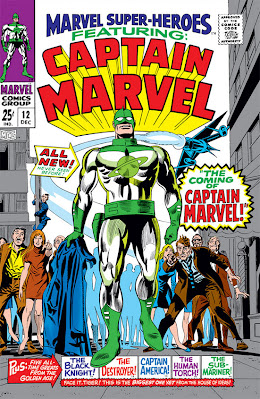When Marvel Super-Heroes morphed into a dedicated reprint mag with issue #21, I suppose the idea was to mix up the content as much as possible with characters who weren't necessarily catching on with the same vigor as Fantastic Four and Amazing Spider-Man, and offer a kind of "grab-bag" of colorful characters that promised variety as well as action. And you only had to take one look at that first cover to see which characters were in need of resuscitation:
Today, of course, it's hard to imagine that the Avengers were ever in such a state where they needed a sales push--or, even more incredibly, that the original Avengers weren't able to catch on as a team. The original Avengers lineup had long since given way to a newer team which at the time were doing pretty well. X-Men, however, was less than a year from cancellation; Sub-Mariner wasn't exactly setting the comics world on fire; and Roy Thomas would soon pick up the scripting reins on Incredible Hulk and breathe new life into the character (as he was doing with Avengers). Eventually, Marvel Super-Heroes would devote itself exclusively to reprinting the Tales To Astonish stories featuring the Hulk and the Sub-Mariner, before finally segueing to reprints of the Hulk's early solo stories.
But before it switched wholly to a reprint title, MSH was quite the showcase for new stories featuring established characters as well as new ones. Perhaps the one character who got the lion's share of the spotlight would be the one who made his debut in back-to-back issues:
It would take a few months before Mar-vell would get his own title--the wait seemed odd, given how much a push Marvel was clearly giving the character. Perhaps even Marvel had an idea of how lacking in fire this concept was, all to lay claim to a trademark.
As for the other new material featured in MSH, I found the stories to be hit-and-miss:
Your mileage may vary. There are probably some genuine Ka-Zar fans out there, but I had absolutely no interest in the character--even with the twist that he was born an English lord, or the fact that his brother happened to be a super-villain. The Medusa story had an interesting premise: the Frightful Four seek to re-enlist her in order to pull off a difficult heist, and the Wizard makes a bargain with her that he'll cure Black Bolt's voice if she agrees to rejoin the Frightful Four permanently. The Guardians of the Galaxy, a totally new "super"-team at the time, group together four men with ties to Earth to fight against their Badoon conquerors. The tale starring Doctor Doom gives us our first meeting (I believe) with Valeria, the woman he loves, as he struggles with Diablo who holds her hostage. And the Black Knight story explores more of Dane Whitman's motivations, and has him meeting his ghostly ancestor, Sir Percy, for the first time.
The "showcase" format for MSH was short-lived, perhaps because Marvel saw the value of having another all-reprint title on the racks along with Marvel's Greatest Comics, Marvel Tales, et al. And by shifting back to reprints, the comic would come full circle, since its original incarnation as Fantasy Masterpieces reprinted Golden Age stories. Still, the covers featuring new material had their appeal--either giving a fresh take on established characters, or throwing a spotlight on a new idea that hopefully would catch on. And with reprinted material supplementing these stories, Marvel Super-Heroes was a pretty good bargain.









2 comments:
Interesting that, in Ka-Zar being an English lord, he was basically 'apeing' Tarzan.
Yes, perhaps no coincidence, that. ;)
Post a Comment